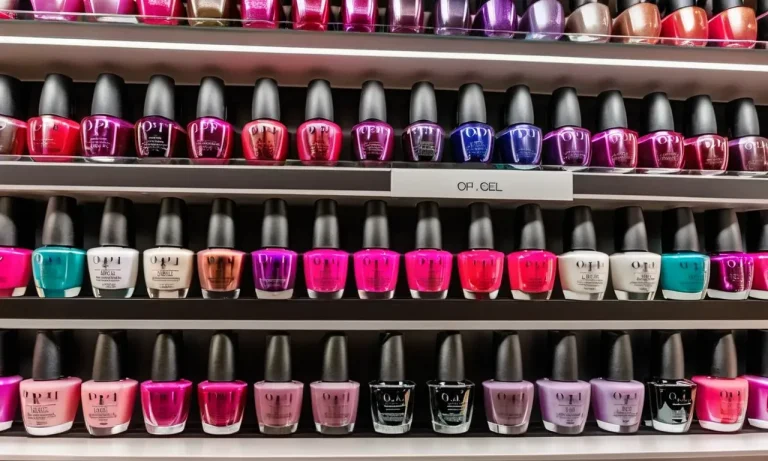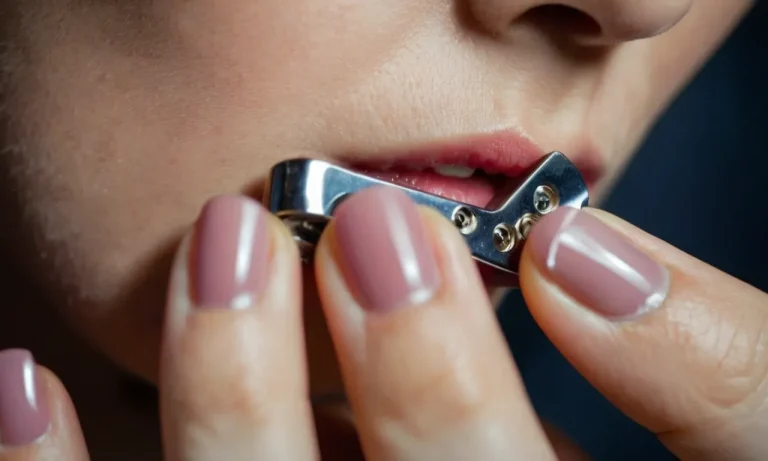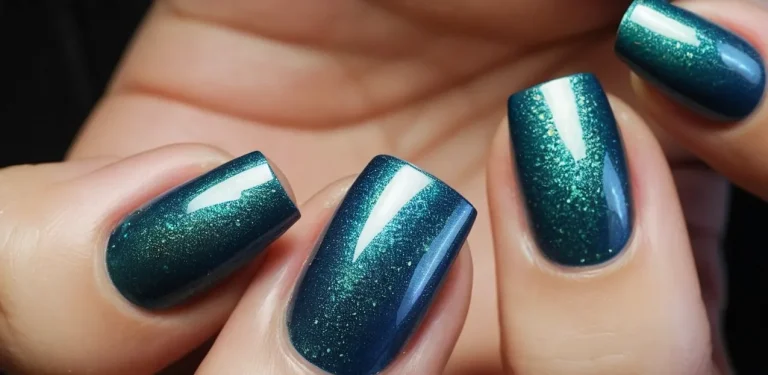Do You Have To Buff Your Nails Before Applying Gel Polish?
With gel manicures becoming increasingly popular, many people wonder if they need to buff their nails before applying gel polish. The short answer is – not necessarily! While buffing can help the gel adhere better in some cases, it is not absolutely required for most people.
In this comprehensive guide, we will explore whether buffing nails is recommended before gel application, the pros and cons, steps for proper buffing, and tips from professionals.
Here’s a quick overview of the key points: Buffing before gel polish is optional for most people and nails. It can remove shine and oils for better adhesion. Be very gentle if buffing – avoid thinning the nails. Focus on buffing the edge and center of the nail, not sides/cuticles.
Use a fine grit file and buff in one direction. Apply gel base coat after buffing to fill in roughness.
Why Do Some Recommend Buffing Before Gel Polish?
There are a few key reasons why some nail experts suggest lightly buffing the natural nail plate before applying a gel manicure. While it may not be absolutely necessary for everyone, there are certain benefits that buffing can provide to help the gel polish adhere better and create a smooth, flawless finish.
Removes Shine and Oil For Better Adhesion
The natural nail surface has a shiny, slightly oily layer that can sometimes prevent gel polish from bonding properly. Gently removing this top layer by buffing creates a lightly textured, matte surface that most gel formulas can grab onto much better.
According to nail care brand ORLY, their studies found that light buffing nearly doubled the adhesion strength compared to gel applied to an unbuffed nail.
Can Fill In Minor Imperfections
Light buffing with a fine grit file levels out small ridges and grooves in the nail plate for a smoother finish. This allows the color gel to glide on evenly with no bumps. The result is a flawless, professional-looking manicure.
As gel brand Gelish notes, skipping this step for nails with surface imperfections often leads to chipping or cracking. An added perk is that buffing nudges back and reshapes the cuticle area for a tidier, polished look.
Professional Salons Often Lightly Buff
Standard salon service for a gel manicure typically includes very gentle buffing before gel polish application, regardless of the condition of the natural nails. Studies by nail product manufacturers have shown this routine boosts adhesion up to 104% while allowing for a super smooth finish.
For very thin or peeling natural nails, estheticians may opt to skip buffing to avoid weakening the nail plate too much. But for most clients, standard procedure is a quick, light pass with a fine grit buffer before gel steps.
Reasons You May Not Need to Buff Before Gels
Most Nails Already Provide Good Adhesion
Gel polish is formulated to bond well to the natural nail plate without buffing. The chemistry of gel allows it to adhere to the keratin layers without roughing up the surface. Many nail techs find that gel polish sticks great to most clients’ nail beds without buffing at all!
As long as you properly prep and dehydrate the nail plate, gel can grab on tightly and polymerize into a strong, flexible layer of color.
Can Lead to Over-Thinning of Nails
Repeated buffing before gel application gradually thins down the nail plates over time. This can weaken nails and increase chances of peeling, cracking, and breakage. It’s best to avoid buffing unless absolutely necessary to maximize nail thickness and strength.
Gel manicures already require some filing for removal, so minimizing other thinning procedures helps maintain health.
Buffing Weakens Nails Over Time
In addition to thinning nails, buffing also roughens the keratin surface. This can make nails more prone toSplitting, peeling, and breakage. The scratches and micro-abrasions created make nails more permeable and fragile.
Limiting buffing preserves the protective nail layers and prevents incremental damage from adding up.
Not Needed on Properly Prepped Nails
For most clients who maintain their nails well, buffing is an unnecessary step before gel polish. As long as the natural nails are filed to shape and thoroughly cleaned and dehydrated, gel will bond tightly without buffing.
Proper nail prep involves removing shine, cleansing away oils and debris, and dehydrating the nail plate. This prepares the surface for adhesion without abrasion.
Proper Technique If You Choose to Buff
Use a Fine Grit File, 180-220 Grit
When prepping nails for gel polish, start by using a fine grit buffer or file between 180-220 grit. Coarse files over 220 grit can create microscopic ridges in the nail plate that gel polish adheres to, making removal more damaging.
A 180/220 grit buffer gently smooths the nail surface without thinning the nail plate.
Gently Buff Center and Free Edge of Nail
Focus superficial buffing on the nail’s center and free edge, avoiding the sides and cuticle area. Repeated buffing near the cuticles can damage the nail matrix. According to nail care experts Sally Beauty, “It is not necessary to buff the sides of your nails”.
Doing so risks over-thinning the sides, causing nails to split and peel.
Avoid Over-Buffing Sidewalls and Cuticles
The nail sidewalls provide support and protection for the nail plate. Over-buffing the sides can compromise strength and flexibility. As Sally Beauty advises: “Do not file back and forth across the nail more than necessary” as this causes excessive wear.
Buff in One Direction Per Nail
To avoid uneven wear, buff gently in one direction, working from cuticle to free edge. Going back and forth erodes more layers from the center, over-thinning that area. The professionals at Essie say to “always file nails in one direction” for even results.
Rinse and Apply Gel Base Coat After
Once buffing is complete, thoroughly rinse nails with water and pat dry. Remove any dust before applying gel base coat. Let the base coat dry completely, about 60 seconds under an LED lamp. This seals and protects nails, allowing the gel color polish to adhere evenly.
Expert Tips for Buffing Before Gel Manicures
Assess Your Nails’ Need First
Before deciding to buff your nails, first examine their condition. Healthy, smooth nails with minimal ridges or flaws often don’t require buffing prior to a gel manicure according to nail care experts at Nails Magazine. Buffing too much can actually damage nails by making them thinner over time.
If your nails seem fairly smooth already, you may be able to skip this step.
Err on the Gentle Side
If your nails do have visible ridges or peely layers, use a gentle touch when buffing according to gel polish brand LeChat. Their experts warn not to over-buff or use too much pressure, which can thin out the nails and cause harm. Instead, focus on light, short strokes rather than heavy pressure.
It’s also best to use a fine-grit buffing block for gel polish rather than a coarse-grit file.
Focus Pressure on Center and Tip
Rather than buffing the entire nail surface, esthetician school Empire Beauty School advises concentrating pressure on the nail’s center and free edge, where ridges and flaws tend to be most noticeable.
Avoid buffing too close to the cuticles or sides of nails, as this can damage the protective nail layers in those areas.
Use Light Strokes and Check Often
The key is to buff gently and briefly, checking the results often. Gel bottle brand Gelish recommends using light, short buffing strokes rather than heavy pressure, and examining nails after every 5-10 strokes. As soon as ridges or shine are reduced, stop buffing.
This prevents over-thining the nails, which can cause breaks or chips later on. The ideal finish is a smooth, matte surface.
Follow With Hydrating Gel Base Coat
Once buffing is complete, it’s important to replenish moisture to the nails according to The Nail Hub professionals. Apply a hydrating gel base coat containing ingredients like vitamin E or jojoba oil.
This replaces some of the oils that may have been stripped away during buffing, and preps nails for gel polish adherence.
The Takeaway: Buffing Before Gels is Optional
When it comes to applying gel polish, many nail enthusiasts ponder whether it’s necessary to buff the nails first. While buffing can provide some benefits, it is ultimately an optional preparatory step before gel manicures. Here’s a closer look at the pros and cons of buffing nails before gels:
Reasons to Buff
There are a few potential advantages to lightly buffing the nails prior to gel application:
- Removes shine – Buffing takes away the natural shine from the nail plate, allowing gel polish to adhere better.
- Smooths surface – Gentle buffing can even out minor ridges and imperfections for a smoother finish.
- Thins nails – Conservatively thinning thick nails can help gel polish last longer before lifting.
- Cleanses – Buffing lightly exfoliates oils and removes unseen debris from the nails.
While buffing offers these prep benefits, it’s vital not to over-buff as it can damage the nails. Many manicurists recommend only buffing periodically, such as every 2-3 gel manicures, rather than every time.
Reasons to Skip Buffing
On the other hand, it’s perfectly fine to skip buffing altogether when applying gel polish. There are a few advantages to avoiding buffing:
- Preserves nail – Without scraping the surface layers, the natural nail stays thicker and stronger.
- Saves time – Skipping this step makes the manicure faster.
- Reduces damage – Less filing means less stress on the nails.
- Allows nail to grow – With no thinning of the surface, the nail can grow out more fully.
As long as the nails are properly prepped and dehydrated, gel polish can bond successfully even without prior buffing. Many people choose to buff only when they notice issues with gel adhesion or longevity.
The Verdict
When preparing for a gel manicure, buffing is an optional step. While it offers some benefits, buffing is not mandatory for gel application and adhesion. The frequency of buffing comes down to personal preference and each individual’s unique nail characteristics.
Some may buff religiously before gels, while others never buff at all. For most people, occasional light buffing provides a nice middle ground without over-thinning the nails. At the end of the day, nails can still look glossy and glamorous with gel polish, whether buffed or not!
Conclusion
While buffing nails before applying gel polish is commonly done at salons, it is not mandatory for most people and manicures. Assess your nail health and adhesion first. If buffing, be extremely gentle – focus on the center and edge of nails. Avoid over-thinning nails from over-buffing.
Follow with a gel base coat to fill in any roughness. With the right prep, gel polish will adhere well without buffing the nails first in many cases.
In summary, buffing nails is an optional step before gel manicures. Take a minimal approach if you do lightly buff, and always follow with a nourishing gel base coat to protect nails and improve adhesion.







